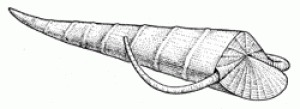Hyolitha (Hyoliths)
Hyolitha are enigmatic animals with small conical shells known from the Palaeozoic Era.
The calcareous shells have a cover (operculum) and two curved supports known as helens. Most are one to four centimeters in length and are triangular or elliptical in cross section. Some species have rings or stripes.
Because hyoliths are extinct and do not obviously resemble any extant group, it is unclear which living group they are most closely related to. They may be molluscs; authors who suggest that they deserve their own phylum do not comment on the position of this phylum in the tree of life.Fossil traces showing a twisted, looped, intestine bear some resemblance to the gut of sipunculan worms. Despite the fact that hyolithid shells are common as fossils, little is known about their ancestry, internal structures, and life mode. They were probably benthic (bottom-dwellers).
The first hyolith fossils appeared about 540 million years ago in the Purella antiqua Zone of the Nemakit-Daldynian Stage of Siberia and in its analogue the Paragloborilus subglobosus–Purella squamulosa Zone of the Meishucunian Stage of China. Hyolith abundance and diversity attain a maximum in the Cambrian, followed by a progressive decline up to their Permian extinction.
Source: http://en.wikipedia.org/wiki/Hyolithid
| ||||||||||||||||||||||||||||||||||||||||||||||||||||||||||||||||||||||||||||||||||||||||||||||||||||||
Virtual museum of the Czech Geological Survey, www.geology.cz, (C) Czech Geological Survey, 2011, v.0.99 [13.12.2011]


![[ENG]](img/vlajka-cr.gif) Česky
Česky 

